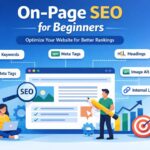
The Ultimate On-Page SEO Checklist for 2025
What is On-Page SEO?
On-page SEO is the practice of optimizing individual web pages to rank higher and attract relevant traffic from search engines. According to Moz:
“On-page SEO refers to both the content and HTML source code of a page that can be optimized, as opposed to off-page SEO, which refers to links and other external signals.”
In essence, it encompasses the visible elements like content, images, and keywords, as well as the hidden ones, such as meta tags and HTML structure. The good news? You have control over these factors—so make it count!
On-Page SEO Checklist for Optimizing Your Website
1. Conduct SERP Research for Effective On page SEO Optimization
SEO is dynamic, and algorithms evolve constantly. Before optimizing, research the search engine results pages (SERPs) for your target keywords. Analyze the top-ranking results:
- Look at URLs, titles, and featured snippets.
- Examine the structure of the top-ranking pages.
- Identify content gaps and questions that aren’t being answered.
2. Keyword Research Strategies for On-Page SEO Success
Keywords remain crucial in SEO. Here’s how to approach it:
- Identify primary and secondary keywords.
- Understand your target audience’s demographics and needs.
- Segment your market to address different search intents: informational (e.g., “best,” “review”) vs. transactional (e.g., “buy,” “discount”).
- Optimize for voice search by including question-based phrases and answers in your content.
3. Craft Short, Keyword-Rich URLs for On-Page SEO
Keep URLs concise and keyword-rich. For example:
- Preferred: mysite.com/seo-checklist
- Avoid: mysite.com/blog/archive/2025/seo-checklist
Google’s algorithm favors URLs with 3-5 words that clearly describe the content.
4. Title Tag Optimization
Title tags are critical for both SEO and user experience. Tips for effective title tags:
- Include 2-3 keywords with the main keyword at the front.
- Limit to 50-60 characters.
- Use a compelling format: “[Engaging Text] [Primary Keyword] [Secondary Keyword] [Engaging Text]”.
5. Enhance On-Page SEO with Optimized H2 Subheadings
H2 tags improve readability and allow for keyword inclusion. Best practices:
- Use clear, scannable subheadings.
- Include target keywords in every 3-4 subheadings naturally.
6. Writing Meta Descriptions
Meta descriptions describe your page content and impact click-through rates (CTR). Here’s how to optimize them:
- Limit to 160-320 characters.
- Include your target keyword naturally.
- Write compelling, action-driven text.
7. Longform Content
Quality content is king. Focus on:
- Writing longform posts over 1,500 words (preferably 2,000+).
- Providing value with evergreen content (e.g., tutorials, guides, resource lists).
- Ensuring relevance and addressing audience needs.
8. Leverage Modifiers for Better Targeting
Modifiers like “best,” “guide,” and “2025” enhance long-tail keyword targeting. Use them in:
- Titles.
- Meta descriptions.
- Body content.
9. Engage Users with Multimedia Content
Visual content increases engagement and reduces bounce rates. Strategies include:
- Adding infographics, images, and videos.
- Optimizing videos with descriptive titles, full descriptions, and relevant thumbnails.
- Including subtitles to accommodate users viewing with sound off.
10. Alt Tag Optimization to Boost On-Page SEO
Alt tags and descriptions help search engines understand your images. Tips:
- Describe the image accurately.
- Include keywords naturally.
- Use descriptive filenames (e.g., “seo-checklist.png”).
11. Internal Linking
Internal links improve site navigation and distribute link equity. Best practices:
- Link to related posts and categories.
- Maintain a clear structure with sitemaps.
- Regularly check for broken links and update them.
12. Elevate On-Page SEO with Schema Markup
Schema markup enhances your page’s appearance in SERPs. Examples include:
- Star ratings for reviews.
- Rich snippets for recipes or FAQs.
- Event details and product information.
13. Use FAQs to Capture Featured Snippets and Boost Rankings
FAQs help capture featured snippets (position 0) and address audience queries. Tips:
- Include FAQs on relevant pages.
- Research related searches to identify common questions.
- Keep answers concise and current.
14. User Reviews: Boost Trust and Rankings
User reviews build trust and improve SEO. Strategies:
- Use review schema to display star ratings.
- Solicit reviews through email or SMS.
- Address negative reviews promptly to build credibility.
15. Mobile-First Indexing: A Critical Factor
Google prioritizes mobile-friendly sites. Ensure:
- Mobile and desktop parity.
- Font sizes and buttons are user-friendly.
- Content is formatted for mobile readability.
- Test your site with Google’s Mobile-Friendly Test tool.
Conclusion
SEO success requires diligence and a strategic approach. By following this on-page SEO checklist, you can ensure your website is optimized to rank higher, attract more traffic, and provide a seamless user experience in 2025.




